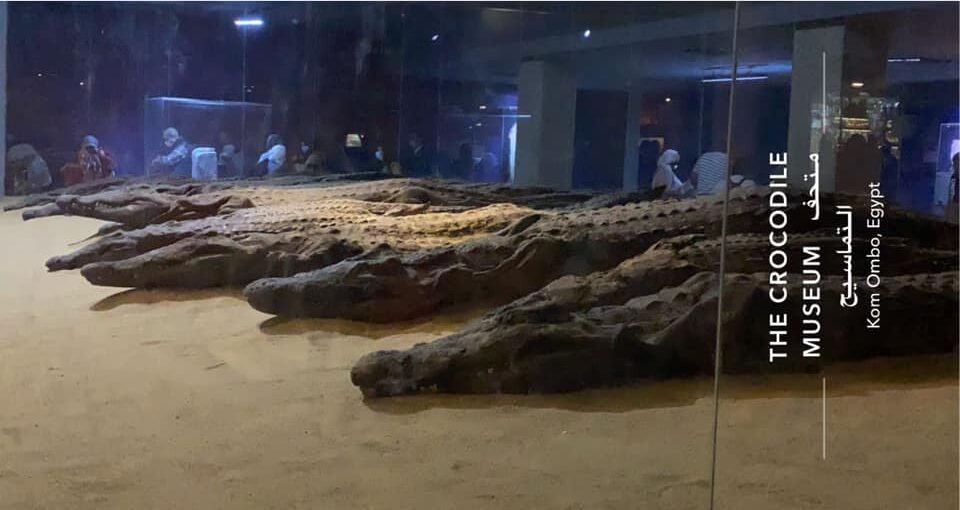The Crocodile Museum is the largest museum in the world for a single animal
Over a hill that rises to 15 meters from an area where the great Nile River bends in the form of an attractive charm, in the bosom of the Kom Ombo temple in Aswan, which ancient Pharaonic beliefs say was dedicated to the worship of Sobek, which was symbolized by the crocodile, is the Crocodile Museum.
The largest museum in the world for a single animal
The Crocodile Museum is the largest international museum for one animal only and contains mummified crocodiles from the days of the Pharaohs.
About the museum
Amal Abdullah, director of the Crocodile Museum, said that the museum contains 74 pieces, including 22 crocodiles, which were placed in the largest crocodile-gathering window in one place in the world.
Using artificial lighting units that suggest this mythical atmosphere, in addition to a cemetery of crocodiles showing how they were buried in dry silt tombs, and a number of artifacts associated with crocodiles and making vows and offerings to the gods.
the Crocodiles represent different ages. ; Crocodiles in the embryonic stage, small crocodiles and large crocodiles of various lengths, up to about 5.5 meters, are displayed, along with 8 crocodiles in coffins and burial scrolls.
The museum display scenario reviews how crocodiles are mummified through five mummies, showing the stages and method of mummification, and how the process was carried out with the same accuracy as when embalming kings and individuals.
Read more : Egyptian Sausage Dish
Museum entry times
The museum opens its doors daily to receive visitors from seven in the morning until eight in the evening, which is the same working hours of the Kom Ombo Temple.
Entry Ticket
The visit is made with one ticket to the temple and museum, and its value is 80 pounds for a foreign tourist and 10 pounds for an Egyptian visitor. The number of visitors to the museum since its opening on January 31, 2012 until today has reached more than 250 thousand tourists.
In addition to the display of the palanquin, which is a wooden table on which mummified crocodiles are placed, offerings are made to them. It is located inside the cemetery as a wooden shrine.
The story of God Sobek (The Crocodile)
The ancient Egyptians worshiped the crocodile and was called the god Sobek (The Crocodile).They worshiped him for protection from the danger of crocodiles, and he became known as the master of the seas and rivers, as the ancient Egyptians believed that the Nile resulted from his race.
In one of the Egyptian myths about creation, he was considered as a supernatural deity, as the god Sobek appeared over the eternal hill (Nun) after the water receded and laying an egg, marking the beginning of creation.
His attributes are also that he is (the master of the flood). Perhaps this name came from the ability of crocodiles to predict the height of the flood waters, as the crocodiles were choosing their shelter above the level of the flood.
The god Sobek was associated with another manifestation of the flood, where he was described as the one who makes plants green (a metaphor for his close association fertility and rebirth)
The Crocodile Museum in Kom Ombo remains a symbol of the embodiment of the ancient Egyptian’s relationship with the crocodile, which reached the point of worship and a strong addition to the Egyptian tourist product.
They worshiped him for protection from the danger of crocodiles, and he became known as the master of the seas and rivers, as the ancient Egyptians believed that the Nile resulted from his race.
Read Also :
- The Meidum pyramid, the royal tomb of king Sneferu
- The Architectural Splendor of Al-Mu’izz Mosque
- Tabali Egyptian street food restaurant in New Cairo
- The Coptic Museum in Egypt
- Dive into the Mysteries of Heraklion: The Lost City Beneath the Waves
accuracy ages artifacts artificial beautiful location Black Desert bosom buried calacified limestone rocks cemetery clove cook crocodile museum display eat egypt great nile Kayaking kilo large crocodiles largest mash meters Mosque Mountain biking mummification museum Obstacle Valley oharaonic oil pan park Preparation process put river Safari Park showing single single animal stage the world units vows worship


